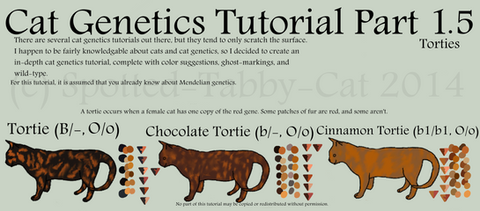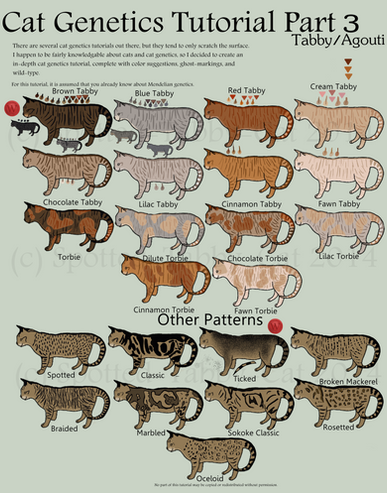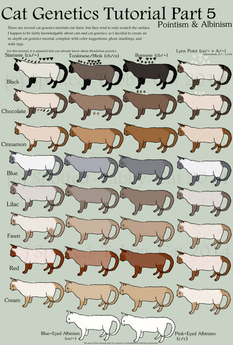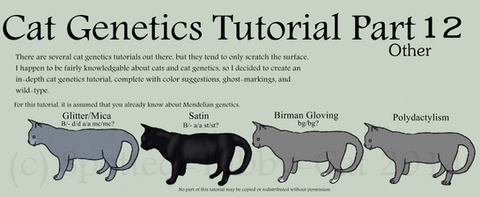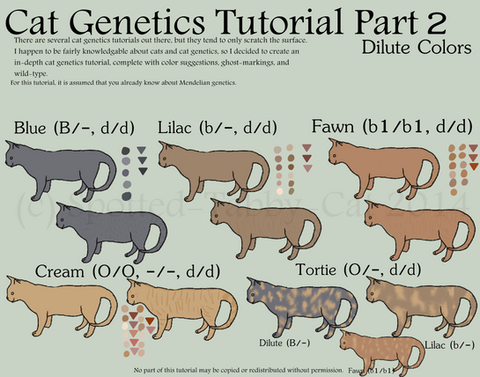HOME | DD
 Spotted-Tabby-Cat — Cat Genetics Tutorial Part 1 (Base Colors)
Spotted-Tabby-Cat — Cat Genetics Tutorial Part 1 (Base Colors)
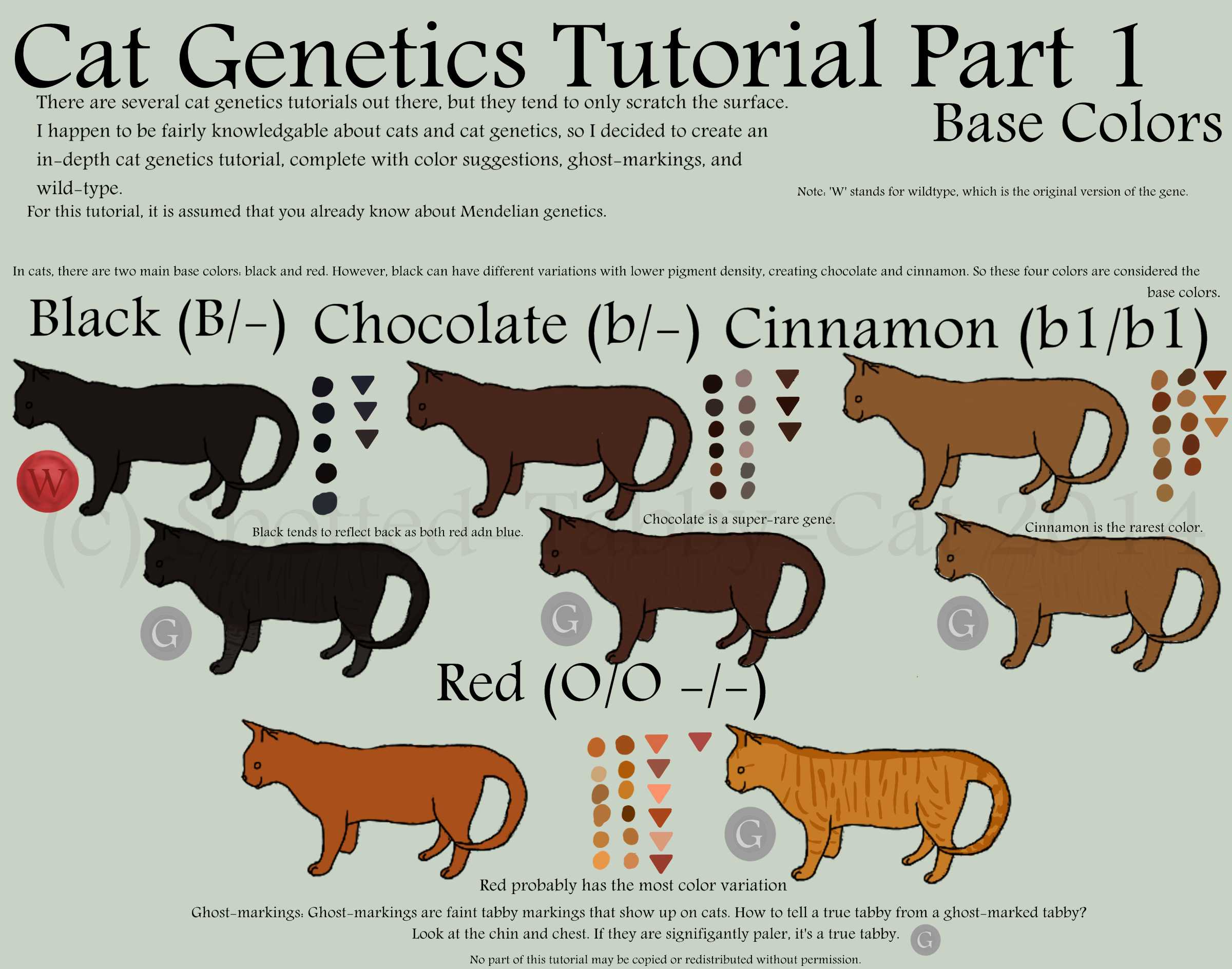
Published: 2014-11-22 17:50:42 +0000 UTC; Views: 45843; Favourites: 380; Downloads: 290
Redirect to original
Description
This tutorial is out of date. Please see more information here .
There are multiple cat genetics tutorials about, but they tend to only cover the basics (base colors, dilutions, tabby, white-spotting, pointism, & tortie/orange). In-depth cat genetics tutorials tend to be lacking. So thus, this. I have no idea how long this will take to be completed. Hopefully before 2016.
The first locus we'll learn about is the B locus. It has three genes: black (B), chocolate (b), and cinnamon (b1). B is dominant over b, and b is dominant over b1. Thus, any cat with B/B, B/b, or B/b1 is black. Any cat with b/b or b/b1 is chocolate, and only cats with b1/b1 are cinnamon. However, most cats are B/B, because chocolate and cinnamon are found almost exclusively in pedigreed and purebred cats. The Havana Brown and British Shorthair both have chocolate, and the Abyssinian and Somali both have cinnamon.
The red gene is interesting because it is only carried on the X chromosome. Since toms and gibs (male cats unable to breed) only have one X gene, they are either non-red, or red. Queens and mollies (female cats unable to breed) have two copies of the X chromosome, they also have two copies of the red gene. So a female cat needs O/O to be red and o/o to be non-red. If a female cat has O/o, then they become a tortie, which are covered in the next part, part 1.5.
And a quick word on ghost-markings. Every cat has ghost-markings, or the faintest tabby markings. For some reason, red cats tend to have the largest contrast in ghost-markings. Few cats have noticeable ghost-markings (excluding red cats). Ghost-markings tend to appear and disappear as a cat ages, and tend to be the most visible on the legs and faces of kittens. Adult cats and older rarely show ghost-markings (excluding red cats). Sometimes, a black cat with ghost-markings will develop little dark brown spots on the inside of the legs with black stripes on them that fade. These tend to just one large spot on each leg, or only on the front legs.
Oh, and the colored circles on the right side for chocolate are highlight colors.
Key:
Red W - Wildtype
Grey G - Ghost-markings
Colored Circle - Color variations/suggestions
Colored Triangles - Nose leather colors
Part 1 (Base Colors):
Cat Genetics Tutorial Part 1 (Base Colors)
Part 1.5 (Torties):
Cat Genetics Tutorial Part 1.5 (Torties)
Part 2 (Dilutions):
Cat Genetics Tutorial Part 2 (Dilutions)
Part 3 (Tabby):
Cat Genetics Tutorial Part 3 (Tabby/Agouti)
Part 4 (White-Spotting):
Cat Genetics Tutorial Part 4 (White)
Part 5 (Pointism & Albinism):
Cat Genetics Tutorial Part 5 (Pointism & Albinism)
Part 6 (Silver & Gold Series):
Cat Genetics Tutorial Part 6 (Silver & Gold Series)
Part 7 (Color Changes):
Cat Genetics Tutorial Part 7 (Color Changes)
Part 8 (Weirdos):
Cat Genetics Tutorial Part 8 (Weirdos)
Part 9 (Hair):
Cat Genetics Tutorial Part 9 (Hair)
Part 10 (Tail):
Cat Genetics Tutorial Part 10 (Tail)
Part 11 (Ears):
Cat Genetics Tutorial Part 11 (Ears)
Part 12 (Other):
Cat Genetics Tutorial Part 12 (Other)
Related content
Comments: 28

👍: 0 ⏩: 0

👍: 0 ⏩: 0

No need to worry; there is no video, just the image.
👍: 1 ⏩: 0

What would be the possible kitten color if the mother is a tuxedu cat with white genes and the father is a blue/ash color?
👍: 0 ⏩: 1

Depending on the genes the mother carries, you could get more black with white, solid black, blue with white, and solid blue (and also possibly other recessive genes if both parents carry them such as chocolate, but those are very rare). In order to get solid foals, the mother would have to carry non-white spotting, and a dilute gene being carried would be necessary for blue offspring. If the mother carries neither of those, only black with white kittens are possible.
👍: 0 ⏩: 0

So if I understand correctly the genotype of a female brown tabby should be o/o and B/-. Our cat has this coat and she gave birth to a female kitten with red and white coat. I don't understand how this can occur since the mother's genotype is o/o.
👍: 0 ⏩: 1

That would be the genotype (plus agouti stuff and such). My best guess would be that either the mother or the kitten is a cryptic tortie and has very minimal markings of one of the colors, appearing to be a solid. You can try looking for small spots of the other color on them.
👍: 0 ⏩: 0

I'm super glad I found this, I really like to get to know about genetics ;v;
👍: 0 ⏩: 1

I'mg lad that you're finding it useful!
👍: 0 ⏩: 0

Hi! Can a cat of whatever color be a carrier of another color? For example, could a solid black cat carry chocolate/cinnamon? :0
👍: 0 ⏩: 1

Cats can certainly be carriers of another color! The base color genes work just like any other dominant-recessive genes, so a black cat could carry either chocolate or cinnamon.
👍: 0 ⏩: 1

omg that's awesome x) That gives me lots of ideas for my warrior cats!
thank you!
👍: 0 ⏩: 1

Glad I could be helpful!
👍: 0 ⏩: 1

I really like talking about cat genetics.
More questions!
Can a cat carry point pattern without expressing it?
Non point x non point (both carrier of point) = point offspring
i'm not sure if that works xD
👍: 0 ⏩: 1

Genetics are fun!
That is also perfectly possible. Just like with black and chocolate and cinnamon, it's a dominant-recessive gene. The difference is that pointism is related to albinism and has different forms. The genes go, in order of dominance, full color (C), pointed (cs) & Burmese (cb) (these are incompletely dominant, so cs/cs gets you a pointed cat, cb/cb a burmese, and cs/cb a tonkinese/mink cat), ca (blue-eyed albinism), c (albinism). Your example would look something like:
C | cs
C | C/C | C/cs
cs | C/cs | cs/cs
👍: 0 ⏩: 1

Omg, yay, so the kit would be genetically possible!
So if I'd bred two cats which would be Ccs and Ccb, I can get a tonkinese/mink??
genetics are hard xD
👍: 0 ⏩: 1

Again, yes! That would be possible. You can always draw a punnet square to see the possibilities of any one cross. Don't worry, genetics gets easier with practice!
👍: 0 ⏩: 1

I'm trying my best. xD
if you don't mind? I'd like your opinion about what colors these cats could be? i know some things are semi-realitic or even totally unrealistc xD But of the offspring I need the colors 
toyhou.se/745460.crimsonstorm
toyhou.se/744591.wolfsong
toyhou.se/744595.floodwave
toyhou.se/744603.nightfall
toyhou.se/744583.sunstar i still can't decide if she's red or cream with or without tabby xD tbh what do you think? here parents are:
toyhou.se/745490.morninglake & toyhou.se/745457.smokeclaw (also what are their colors? i think smoke is sepia mink/tonkinese with a bit spotted tabby?)
also i'd like you opinion about this couple, is it gentically correct? i'm thinking about changing shadowrunner's design but idk??
toyhou.se/745474.shadowrunner x toyhou.se/745234.blackiver
the kits are toyhou.se/744734.blossomstar & toyhou.se/744866.whitekit
shadowrunner's other mate: toyhou.se/745480.skyswing
their kits:
toyhou.se/744673.cherryclaw & toyhou.se/745184.maplestar
👍: 0 ⏩: 1

Sorry for the late response. You have a lot of cats listed there, so I'll be going through them on sta.sh (Here ). It'll probably take me a while, so I'll comment here again or note you when I'm done, but feel free to look there to see what I do have done. Everything there is listed solely for realism purposes, but do whatever you want in terms of adding unrealistic features to your characters. Hopefully it will be helpful.
👍: 0 ⏩: 1

Thank you so much!! <3
👍: 0 ⏩: 0

To clarify, if a male cat has a dominant red gene, will that cat always be red, regardless of the eumelanin genes (or are eumelanin and phaeomelanin an either-or situation, were you only get one or the other)? Also, are lowercase o's meant to indicate a lack of phaeomelanin genes? I'm also a little confused on what the dashes are supposed to be, are they meant to indicate any 'submissive' gene could potentially be there (ie B/- could mean B/b, B/b1, etc)? If so, why is red written as O/O -/-? Ahhh I'm sorry if these are silly questions
👍: 1 ⏩: 1

Yep on pretty much all accounts! If present, phaeomelanin overrides eumelanin, so a male cat with O will be red and whatever eumelanin genes he has won't affect anything. A cat with O BB and a cat with O bb1 will both be red. The lowercase o does signify a lack of phaeomelanin, though it can often be left out when writing genotypes. The dashes do signify any recessive genes, as they won't affect the appearance of a cat with a dominant gene (Bb, BB, and Bb1 all look the same). Red is written as O/O -/- for female cats as they would have to have the two orange genes to not be tortie. Since the red overrides any eumelanin traits, whatever is there does not matter for the phenotype of the cat and is therefore shown as dashes. Don't worry, these aren't silly questions!
👍: 0 ⏩: 1

Ah thank you very much! Sorry for the late response >.> I was also poking around your other tutorials and while I think I understand the majority of them, I was hoping you could answer a few more questions? Regarding the white spotting, I was wondering if there were specific known genes connected to each grade, or if was just a sort of random grab-bag (I use the term loosely, I know that it's all technically genetic 

👍: 0 ⏩: 1

I'm always willing to answer questions. Some people think that white-spotting functions in a more semi-dominant fashion (Ws/Ws cats having more white than Ws/ws cats). In my opinion, it is governed mostly by polygenes (a bunch of little genes that turned on or off create effects in pattern, hue, shade, etc.). Cats can inherit more or less 'more white' genes from their parents. Conditions in the womb can also affect white markings (Examples in cloned cat: images.myshared.ru/22/1268171/… (hard to see,so also: ) examples in cloned horses: 4.bp.blogspot.com/-kSggCoMOULM… ). The grades are just a system to try and describe the amount of white concisely. Pointism would be perfectly possible in one a chimera's genomes. Honestly, I think that a fair amount of 'chimera' cats are simply torties or calicos. Pointism and silver/gold are very rare in moggy populations. I have only ever seen one pointed moggy cat, and never a silver or gold one. There are exceptions (i.e. many pointed moggies in the area where pointism originates from), but in general it simply isn't present in most moggy populations. The main reason for their scarcity is that they first came to be in pedigreed cats, and therefore simply rarely spread into moggy populations. One can argue that male cats get (some) of their coloring solely from the mother as the orange gene (determining whether the cat with be red or on the black scale) is on the X, and males get their sole X from their mother. I've had much the same luck finding eye color information as you. I don't think any studies have been done on it. The one thing is that (generally) cats don't have blue eyes without pointism or white-spotting (although there are exceptions). Other than that, just look at photos and try to judge as best as you can.
👍: 0 ⏩: 1

Hmm... I'm not 100% sure, in my outside research I've come across some seemingly trustworthy websites that say that males get the color from the mother (ie [x] [x] [x] [x] ). Generally the research I've seen says that both red and black are carried on the X chromosome, which confuses me since there are also a fair number of sites that address the red gene as though it's uniquely sex linked. I hate to argue, espicially since it seems like you really know your stuff, but I'm not just not sure what to think. Reguardless, on a different note, I was wondering if you could comment on the accuracy of these visuals , particuarly the bits about the color variations? As always, I appreciate your willingness to answer ^^
👍: 1 ⏩: 1

The mother cat does decide the base color for the offspring with the sex-linked red gene, as shown in many of the charts on the linked sites. Probably the reason the sites are saying black is also carried this way is that they are simplifying 'no red' to black. The red gene essentially simply turns on extra phaeomelanin and turns off extra melanin production, so a cat without is simply black. The genes that change to chocolate or cinnamon are on different chromosomes. As for the the visuals, they seem pretty okay, though the colors might be a bit exaggerated and I'm not too sure about the walnut and honey. The best way to see if a hue might be possible is Google Images. Just search a color and look at a bunch of the photos.
👍: 1 ⏩: 0

My drawing for a Tumblr submission illustrates how the blonde gene might possibly manifest should the mutation occur in cats. In humans, blonde is a low eumelanin hair color that is polygenetic with and recessive to brown and black. So far, the blonde gene has yet to occur in cats and I only hear of yellowish orange/ginger, cream, apricot, and fawn cats be called "blonde."
Hypothetical Blonde Series: aeluruso.tumblr.com/post/14995…
For the posited blonde series, blonde gene + phaeomelanin (orange/ginger, cream, and apricot) = called yellow, just like inhibitor/silver gene + phaeomelanin = called cameo.
Messybeast has charts for a Hypothetical Tan Series and a Hypothetical Merle series and how they might occur in cats if they did occur. Merle occurs in dogs, which have it as a dominant gene, and mice, which have it as a recessive gene, but has yet to occur in cats. Tan occurs in dogs, rabbits, mice, and Guinea pigs, but has yet to occur in cats.
Color and Pattern Charts by Messybeast: messybeast.com/colour-charts.h…
This dog genetics website has information and details on the tan gene, including point tan, saddle tan, and creeping tan, and the merle gene, including patch variation and base color variation.
Dog Color Genetics: www.doggenetics.co.uk
Solid colored cats, especially grey cats, can have somewhat lighter muzzles, bellies, and toes somewhat reminescent of pangaré or mealy on horses and donkeys. Also, tabbies can have much lighter bellies. I'm not sure if cats, whether tabbies or solid ones, truly have Pangaré. I've yet to hear of that gene occurring in cats.
Pangaré on Wikipedia: en.m.wikipedia.org/wiki/Pangar…
👍: 0 ⏩: 0
